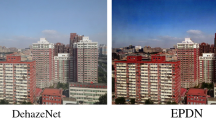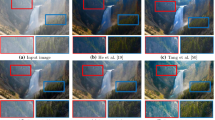Abstract
In this paper, we propose a progressive encoding-decoding network (PEDN) for image dehazing. First, we built a basic dehaze unit to progressively process the image to achieve image dehazing in stages. The basic dehaze unit is composed of a feature memory module and an encoding-decoding network. The feature memory module is used to transfer features at different progressive stages. The encoding-decoding network is responsible for feature extraction, encodes and decodes images by fusing different levels of pyramid features. The basic dehaze unit shares parameters during the progressive process, which effectively reduces the difficulty of network training and improves the fitting speed. The proposed model is an end-to-end image dehazing network, which does not depend on the atmospheric scattering model. In addition, we extracted the depth information of the hazy image and obtained its pyramid features, and incorporated the depth information into the feature extraction to guide the network to restore clear images more accurately. Experiments show that the our method not only performs well on synthetic datasets, but also has excellent performance on real-world hazy images. It is superior to current image dehaze methods in quantitative indexes and visual perception. Code has been made available at https://github.com/LWQDU/PEDN.














Similar content being viewed by others
References
Ancuti CO, Ancuti C, Timofte R, De Vleeschouwer C (2018) O-haze: a dehazing benchmark with real hazy and haze-free outdoor images. In: Proceedings of the IEEE Conference on Computer Vision and Pattern Recognition Workshops, pp 754–762
Ancuti C, Ancuti CO, De Vleeschouwer C (2016) D-hazy: A dataset to evaluate quantitatively dehazing algorithms. In: 2016 IEEE International Conference on Image Processing (ICIP), pp 2226–2230. IEEE
Ancuti C, Ancuti CO, Timofte R, De Vleeschouwer C (2018) I-haze: a dehazing benchmark with real hazy and haze-free indoor images. In: International Conference on Advanced Concepts for Intelligent Vision Systems. Springer, pp 620–631
Berman D, Avidan S, et al (2016) Non-local image dehazing. In: Proceedings of the IEEE Conference on Computer Vision and Pattern Recognition, pp 1674–1682
Cai B, Xu X, Jia K, Qing C, Tao D (2016) Dehazenet: An end-to-end system for single image haze removal. IEEE Transactions on Image Processing 25(11):5187–5198
Chen C, Wang G, Peng C, Zhang X, Qin H (2019) Improved robust video saliency detection based on long-term spatial-temporal information. IEEE transactions on image processing 29:1090–1100
Chen C, Wang G, Peng C, Fang Y, Zhang D, Qin H (2021) Exploring rich and efficient spatial temporal interactions for real-time video salient object detection. IEEE Transactions on Image Processing 30:3995–4007
Chen D, He M, Fan Q, Liao J, Zhang L, Hou D, Yuan L, Hua G (2019) Gated context aggregation network for image dehazing and deraining. In: 2019 IEEE Winter Conference on Applications of Computer Vision (WACV), pp 1375–1383 . IEEE
Chen C, Song J, Peng C, Wang G, Fang Y (2021) A novel video salient object detection method via semisupervised motion quality perception. IEEE Transactions on Circuits and Systems for Video Technology
Dong H, Pan J, Xiang L, Hu Z, Zhang X, Wang F, Yang M-H (2020) Multi-scale boosted dehazing network with dense feature fusion. In: Proceedings of the IEEE/CVF Conference on Computer Vision and Pattern Recognition, pp 2157–2167
Engin D, Genç A, Kemal Ekenel H (2018) Cycle-dehaze: Enhanced cyclegan for single image dehazing. In: Proceedings of the IEEE Conference on Computer Vision and Pattern Recognition Workshops, pp 825–833
Fan G, Hua Z, Li J (2021) Multi-scale depth information fusion network for image dehazing. Applied Intelligence 51(10):7262–7280
Fan Z,Wu H, Fu X, Hunag Y, Ding X (2018) Residual-guide feature fusion network for single image deraining. arXiv:1804.07493
Fattal R (2008) Single image dehazing. ACM transactions on graphics (TOG) 27(3):1–9
Fazlali H, Shirani S, McDonald M, Brown D, Kirubarajan T (2020) Aerial image dehazing using a deep convolutional autoencoder. Multimedia Tools and Applications 79(39):29493–29511
Feng X, Li J, Hua Z, Zhang F (2021) Low-light image enhancement based on multi-illumination estimation. Applied Intelligence 1–21
Fu X, Liang B, Huang Y, Ding X, Paisley J (2019) Lightweight pyramid networks for image deraining. IEEE transactions on neural networks and learning systems 31(6):1794–1807
Galdran A, Vazquez-Corral J, Pardo D, Bertalmio M (2016) Fusion-based variational image dehazing. IEEE Signal Processing Letters 24(2):151–155
Gibson KB, Nguyen TQ (2014) An analysis and method for contrast enhancement turbulence mitigation. IEEE transactions on image processing 23(7):3179–3190
He K, Sun J, Tang X (2010) Single image haze removal using dark channel prior. IEEE transactions on pattern analysis and machine intelligence 33(12):2341–2353
Hochreiter S, Schmidhuber J (1997) Long short-term memory. Neural computation 9(8):1735–1780
Hua Z, Fan G, Li J (2020) Iterative residual network for image dehazing. IEEE Access 8:167693–167710
Jin Y, Sheng B, Li P, Chen CP (2020) Broad colorization. IEEE transactions on neural networks and learning systems 32(6):2330–2343
Khorram A, Khalooei M, Rezghi M (2021) End-to-end cnn+ lstm deep learning approach for bearing fault diagnosis. Applied Intelligence 51(2):736–751
Kim J-Y, Kim L-S, Hwang S-H (2001) An advanced contrast enhancement using partially overlapped sub-block histogram equalization. IEEE transactions on circuits and systems for video technology 11(4):475–484
Kim J, Kwon Lee J, Mu Lee K (2016) Deeply-recursive convolutional network for image super-resolution. In: Proceedings of the IEEE Conference on Computer Vision and Pattern Recognition, pp 1637–1645
Kingma DP, Ba J (2014) Adam: A method for stochastic optimization. arXiv:1412.6980
Land EH, McCann JJ (1971) Lightness and retinex theory. Josa 61(1):1–11
Li B, Ren W, Fu D, Tao D, Feng D, Zeng W, Wang Z (2019) Benchmarking single-image dehazing and beyond. IEEE Transactions on Image Processing 28(1):492–505
Li J, Feng X, Hua Z (2021) Low-light image enhancement via progressive-recursive network. IEEE Transactions on Circuits and Systems for Video Technology
Lin H-Y, Lin C-J (2017) Using a hybrid of fuzzy theory and neural network filter for single image dehazing. Applied Intelligence 47(4):1099–1114
Ling Z, Fan G, Gong J, Guo S (2019) Learning deep transmission network for efficient image dehazing. Multimedia Tools and Applications 78(1):213–236
Li B, Peng X, Wang Z, Xu J, Feng D (2017) Aod-net: All-in-one dehazing network. In: Proceedings of the IEEE International Conference on Computer Vision, pp 4770–4778
Liu F, Shen C, Lin G, Reid I (2015) Learning depth from single monocular images using deep convolutional neural fields. IEEE transactions on pattern analysis and machine intelligence 38(10):2024–2039
Liu X, Zhang H, Cheung Y-m, You X, Tang YY (2017) Efficient single image dehazing and denoising: An efficient multi-scale correlated wavelet approach. Computer Vision and Image Understanding 162:23–33
Liu X, Ma Y, Shi Z, Chen J (2019) Griddehazenet: Attention-based multi-scale network for image dehazing. In: Proceedings of the IEEE International Conference on Computer Vision, pp 7314–7323
Mei K, Jiang A, Li J, Wang M (2018) Progressive feature fusion network for realistic image dehazing. In: Asian Conference on Computer Vision. Springer, pp 203–215
Min X, Zhai G, Gu K, Zhu Y, Zhou J, Guo G, Yang X, Guan X, Zhang W (2019) Quality evaluation of image dehazing methods using synthetic hazy images. IEEE Transactions on Multimedia 21(9):2319–2333
Narasimhan SG, Nayar SK (2000) Chromatic framework for vision in bad weather. In: Proceedings IEEE Conference on Computer Vision and Pattern Recognition. CVPR 2000 (Cat. No. PR00662), vol. 1, pp. 598–605 . IEEE
Narasimhan SG, Nayar SK (2002) Vision and the atmosphere. International journal of computer vision 48(3):233–254
Nguyen H, Tran KP, Thomassey S, Hamad M (2021) Forecasting and anomaly detection approaches using lstm and lstm autoencoder techniques with the applications in supply chain management. International Journal of Information Management 57:102282
Pang Y, Sun M, Jiang X, Li X (2017) Convolution in convolution for network in network. IEEE transactions on neural networks and learning systems 29(5):1587–1597
Qin X, Wang Z, Bai Y, Xie X, Jia H (2020) Ffa-net: Feature fusion attention network for single image dehazing. In: AAAI, pp 11908–11915
Qu Y, Chen Y, Huang J, Xie Y (2019) Enhanced pix2pix dehazing network. In: Proceedings of the IEEE Conference on Computer Vision and Pattern Recognition, pp 8160–8168
Raj NB, Venketeswaran N (2020) Single image haze removal using a generative adversarial network. In: 2020 International Conference on Wireless Communications Signal Processing and Networking (WiSPNET), pp 37–42 . IEEE
Ren W, Liu S, Zhang H, Pan J, Cao X, Yang M-H (2016) Single image dehazing via multi-scale convolutional neural networks. In: European Conference on Computer Vision. Springer, pp 154–169
Ren W, Ma L, Zhang J, Pan J, Cao X, Liu W, Yang M-H (2018) Gated fusion network for single image dehazing. In: Proceedings of the IEEE Conference on Computerd Vision and Pattern Recognition, pp 3253–3261
Ronneberger O, Fischer P, Brox T (2015) U-net: Convolutional networks for biomedical image segmentation. In: International Conference on Medical Image Computing and Computer-assisted Intervention. Springer, pp 234–241
Shahid F, Zameer A, Muneeb M (2020) Predictions for covid-19 with deep learning models of lstm, gru and bi-lstm. Chaos, Solitons & Fractals 140:110212
Shao Y, Li L, Ren W, Gao C, Sang N (2020) Domain adaptation for image dehazing. In: Proceedings of the IEEE/CVF Conference on Computer Vision and Pattern Recognition (CVPR)
Sharma T, Agrawal I, Verma NK (2020) Csidnet: Compact single image dehazing network for outdoor scene enhancement. Multimedia Tools and Applications 79(41):30769–30784
Singh D, Kumar V, Kaur M (2019) Single image dehazing using gradient channel prior. Applied Intelligence 49(12):4276–4293
Stark JA (2000) Adaptive image contrast enhancement using generalizations of histogram equalization. IEEE Transactions on image processing 9(5):889–896
Tarel J-P, Hautiere N (2009) Fast visibility restoration from a single color or gray level image. In: 2009 IEEE 12th International Conference on Computer Vision, pp 2201–2208 . IEEE
Wang Y-K, Fan C-T (2014) Single image defogging by multiscale depth fusion. IEEE Transactions on image processing 23(11):4826–4837
Wiedemann S, Müller K-R, Samek W (2019) Compact and computationally efficient representation of deep neural networks. IEEE transactions on neural networks and learning systems 31(3):772–785
Zhang T, Li J, Hua Z (2021) Iterative multi-scale residual network for deblurring. IET Image Processing 15(8):1583–1595
Zhang W, Li J, Hua Z (2021) Attention-based tri-unet for remote sensing image pan-sharpening. IEEE Journal of Selected Topics in Applied Earth Observations and Remote Sensing 14:3719–3732
Zhang H, Patel VM (2018) Densely connected pyramid dehazing network. In: Proceedings of the IEEE Conference on Computer Vision and Pattern Recognition, pp 3194–3203
Zhu J-Y, Park T, Isola P, Efros AA (2017) Unpaired image-to-image translation using cycle-consistent adversarial networks. In: Proceedings of the IEEE International Conference on Computer Vision, pp 2223–2232
Zhu Q, Mai J, Shao L (2015) A fast single image haze removal algorithm using color attenuation prior. IEEE transactions on image processing 24(11):3522–3533
Author information
Authors and Affiliations
Corresponding author
Ethics declarations
Competing of interest
The authors declare that they have no known competing financial interests or personal relationships that could have appeared to influence the work reported in this paper.
Conflicts of interest
All authors declare that there are no conflicts of interest.
Additional information
Publisher's Note
Springer Nature remains neutral with regard to jurisdictional claims in published maps and institutional affiliations.
Wang Li and Guodong Fan contributed equally to this work.
Rights and permissions
Springer Nature or its licensor (e.g. a society or other partner) holds exclusive rights to this article under a publishing agreement with the author(s) or other rightsholder(s); author self-archiving of the accepted manuscript version of this article is solely governed by the terms of such publishing agreement and applicable law.
About this article
Cite this article
Li, W., Fan, G. & Gan, M. Progressive encoding-decoding image dehazing network. Multimed Tools Appl 83, 7657–7679 (2024). https://doi.org/10.1007/s11042-023-15638-w
Received:
Revised:
Accepted:
Published:
Issue Date:
DOI: https://doi.org/10.1007/s11042-023-15638-w




